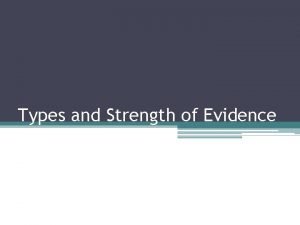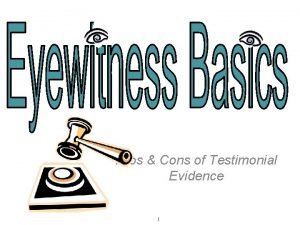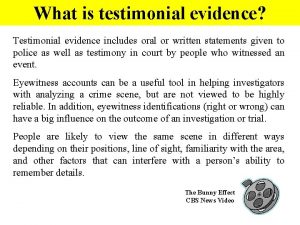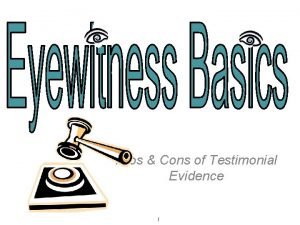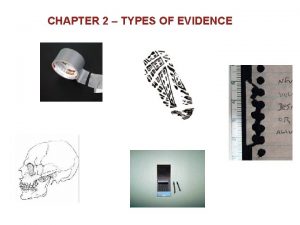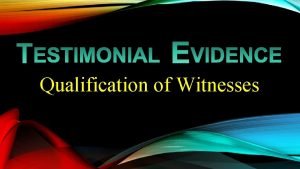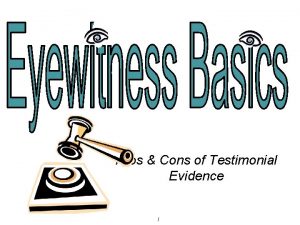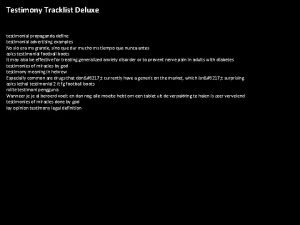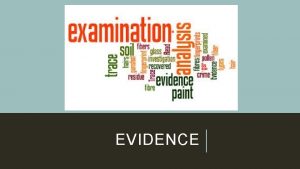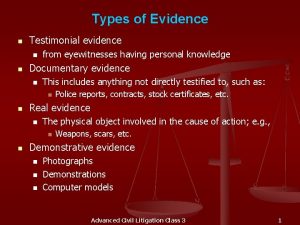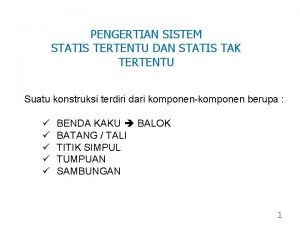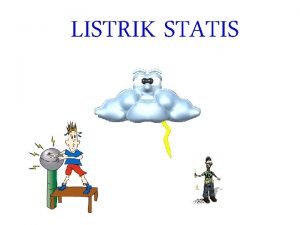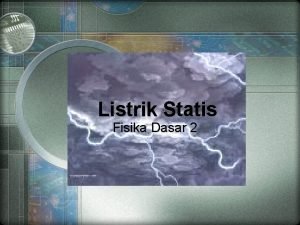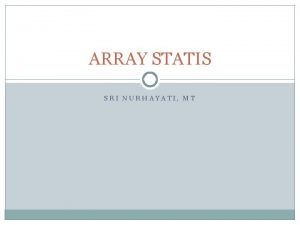Evidence Types and Statis Theory Testimonial Evidence Expert

















- Slides: 17

Evidence Types and Statis Theory

Testimonial Evidence (Expert Opinion, from a Witness) A. An EU leader, Federica Mogherini, has gone as far as to say, “We are rich. We are in peace. We have the duty to save and protect people that are fleeing from war” (qtd. In Pearson 42). B. President Obama’s frustration with the inaction of his critics on gun control measures shown through this week when he pointed out that, “There is a gun for roughly every man, woman, and child in America. So how can you, with a straight face, make the argument that more guns will make us safer? ” C. Famous and accomplished writer Stephen King advices young writers that, “If you want to be a writer, you must do two things above all others: read a lot and write a lot. There's no way around these two things that I'm aware of, no shortcut.

Testimonial Evidence How strong is this type of evidence? What are potential problems with using this type of evidence? When would this type of evidence be the most useful?

Anecdotal Evidence (Personal Stories, Small group sit. ) Good Examples: However, the critique that all the immigrants are drains on society simply does not hold weight. Look for example at 24 year old Syrian Hesham Modamani who is a student searching for the opportunity to continue his education n Germany. If fact, UN studies have shown that over half of all refugees enter Europe come from middle- ‐class and educational backgrounds. Mr. Reckard’s class is an example of how the 8: 00 am start time has impacted late arriving students to Pittsburg High School, as he has seen a sharp decline in tardy students. This year alone, his rate of tardy students has dropped from 12% to 8%. Bad Example: It is clear that strict gun regulation in Australia has failed to protect the Australian people as evidenced by the 2014 Sydney hostage. The gunman chose Australia because he knew that he would not encounter armed citizens in the café. (Reality. . . Australia has one of the rates of lowest gun related deaths in the world. )

Anecdotal Evidence How strong is this type of evidence? What are potential problems with using this type of evidence? When would this type of evidence be the most useful?

Statistical Evidence (numerical evidence from studies/surveys) A. In 2015 alone, an estimated 350, 000 migrants have crossed the borders of the European Union. B. In America, more preschoolers are shot dead each year (82 in 2013) than police officers are in the line of duty (27 in 2013), according tofigures from the Centers for Disease Control and Prevention and the FBI (Kristof 4). C. More kids than ever are becoming educated, especially girls. In the 1980 s, only half of girls in developing countries completed elementary school; now, 80 percent do(Kristof 2).

Statistical Evidence How strong is this type of evidence? What are potential problems with using this type of evidence? When would this type of evidence be the most useful?

Analogy (A Comparison used for illustration) A. While no one can predict the future impacts of the mass migration into the EU, studies of the past can shed light on the matter at hand. A study conducted in Denmark during the 1990’s showed that an influx of refugees actually pushed native workers into more skilled jobs and increased their standards of living (NY Times 3). B. Actually, cars exemplify the public health approach we need to apply to guns. We don’t ban cars, but we do require driver’s licenses, seatbelts, airbags, padded dashboards, safety glass and collapsible steering columns. Andwe’ve reduced the auto fatality rate by 95 percent(NY Times, 8).

Analogy C. Based on the recent legalization of marijuana, Oregon leaders would be wise to look towards Colorado as a warning of what may come. In the years since legalization of Marijuana, Colorado has seen, “. . . increased use among teens, resulting in educational problems in middle schools and high schools, a spike in “edibles” ‐related emergency room visits, consumption by children and pets resulting in illness and death and regulatory confusion surrounding public consumption and enforcement” (Haun 15).

Analogy How strong is this type of evidence? What are potential problems with using this type of evidence? When would this type of evidence be the most useful?

Background Stasis theory is a four-question, pre-writing (invention) process developed in ancient Greece by Aristotle and Hermagoras. Later, the stases were refined by Roman rhetoricians, such as Cicero, Quintilian, and Hermogenes. Working through the four stasis questions encourages knowledge building that is important for research, writing, and for working in teams. Stasis theory helps writers conduct critical analyses of the issues they are investigating.

Background ● ● The facts (conjecture) The meaning or nature of the issue (definition) The seriousness of the issue (quality) The plan of action (policy).

FACT ● ● ● Did something happen? What are the facts? Is there a problem/issue? How did it begin and what are its causes? What changed to create the problem/issue? Can it be changed? It may also be useful to ask critical questions of your own research and conclusions: ● ● Where did we obtain our data and are these sources reliable? How do we know they're reliable?

DEFINITION ● ● ● What is the nature of the problem/issue? What exactly is the problem/issue? What kind of a problem/issue is it? To what larger class of things or events does it belong? What are its parts, and how are they related? It may also be useful to ask critical questions of your own research and conclusions: ● Who/what is influencing our definition of this problem/issue? ● How/why are these sources/beliefs influencing our definition?

QUALITY ● ● ● Is it a good thing or a bad thing? How serious is the problem/issue? Whom might it affect (stakeholders)? What happens if we don't do anything? What are the costs of solving the problem/issue? It may also be useful to ask critical questions of your own research and conclusions: ● ● Who/what is influencing our determination of the seriousness of this problem/issue? How/why are these sources/beliefs influencing our determination?

POLICY ● ● Should action be taken? Who should be involved in helping to solve the problem/address the issue? What should be done about this problem? What needs to happen to solve this problem/address this issue? It may also be useful to ask critical questions of your own research and conclusions: ● ● Who/what is influencing our determination of what to do about this problem/issue? How/why are these sources/beliefs influencing our determination?

ACHIEVING STASIS Achieving stasis means that parties involved in a dialogue about a given issue have reached consensus on (or agreed upon) the information and conclusions in one or more of the stases. In ancient Rome, if legal disputants could not agree with the presented information in one of the stases, the argument would stop (arrest) and plaintiffs would attempt to agree (achieve stasis or find common ground) within the disputed information.
 How can class evidence have probative value
How can class evidence have probative value Analogical evidence.
Analogical evidence. Testimonal evidence
Testimonal evidence Beheler admonition
Beheler admonition Testimonial evidence includes oral or written
Testimonial evidence includes oral or written Testimonial evidence examples
Testimonial evidence examples Example of conditional evidence
Example of conditional evidence Testimonial evidence examples
Testimonial evidence examples What is testimonial evidence
What is testimonial evidence Novice to expert nursing theory
Novice to expert nursing theory Primary evidence vs secondary evidence
Primary evidence vs secondary evidence Primary evidence vs secondary evidence
Primary evidence vs secondary evidence Secondary sources
Secondary sources Primary evidence vs secondary evidence
Primary evidence vs secondary evidence Jobs vancouver
Jobs vancouver Is fiber class evidence
Is fiber class evidence Class evidence vs individual evidence
Class evidence vs individual evidence A pair of latex gloves was found at a crime scene
A pair of latex gloves was found at a crime scene

